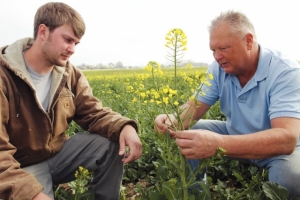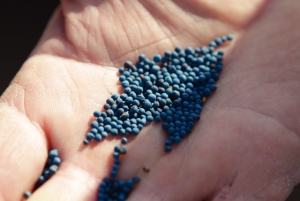A new crop: Farm family introduces rapeseed to Wayne County
By Steve Herring
Published in News on April 2, 2012 1:46 PM

News-Argus/MICHAEL BETTS
William Jackson, right, and his son, Dex, check one of their rapeseed plants in a field west of Mount Olive. The Jacksons have planted 375 acres with rapeseed plants this season after William's father, Dexter, decided to invest in a new crop. Rapeseed produces seeds that are used as a lubricant and in plastic products.

News-Argus/MICHAEL BETTS
The rapeseed is a little smaller than a BB. Its blue color is from chemical treatments to prevent diseases in the plant.
MOUNT OLIVE -- With 65 years of experience in working the soil, Dexter Jackson, 80, doesn't mind being called an old-school farmer. But when he read a magazine article about an unusual crop, with an even more unusual name, he didn't hesitate to suggest to his son, William, that they try growing it.
Now people scratch their heads as they drive by the fields of the crop with the odd name -- rapeseed -- with its bright yellow flowers growing on land that once was the exclusive domain of tobacco. People from as far as 60 miles away have come to talk to an agronomist about the crop, and hundreds of local residents have stopped to check out the plants.
Some people have even cut it and eaten it like turnip greens, though the taste might be more bitter than turnips, William Jackson said.
"The agronomist comes from England and he travels all over the world," he said. "He's come twice since the fall and he is going to come back one more time before we harvest it."
Dexter Jackson said he didn't mind trying something new.
But his son said his first thought when his father mentioned the crop was, "Daddy, have you got some extra money? That is gambling, I tell you."
"I had never seen a field of it," the younger Jackson said. "We probably have $100,000 invested in this crop so far. So you have got some faith there.
"Daddy read about it in a book and he said, 'Let's look into that.' So we contacted the company in Greensboro. At that point we had a meeting set up in Greenville. They had a farmers meeting set up. There were five farmers there. That's all that were there. We visited with them and decided to grow 400 acres, but it got so dry I just quit planting and stopped with 375. I think there is around 4,000 acres of it grown in North Carolina."
Rapeseed is grown in the northeastern and the southwestern parts of the state, he said. It also is grown in China, Europe and Canada.
The harvest will be taken to Perdue Farms in Greenville, where it will be stored for the company, Crop Technologies, the Jacksons contracted with. The seeds will be converted for use in plastic products.
One product is a lubricant that is sprayed between the sheets of plastic used to wrap items stacked on pallets so that the wrap doesn't stick. Other uses include lamp oils, soap making, lubricating oils and fuel.
Rapeseed has high erucic oil content that is mildly toxic to humans in large doses. Rapeseed with a lower erucic acid can be used to make an edible oil.
The plant, that can grow to be three- to five-feet-tall, is related to cauliflower, turnip, broccoli, mustard and cabbage.
Jackson's father agrees that farming a new crop takes a lot of faith.
"Farming is getting so expensive now you have got to try and make a living," Dexter Jackson said. "It (rapeseed) is supposed to do $100 better an acre than wheat in profit. At $100 an acre, 400 acres you know is $40,000.
"You diversify more. We are going out of tobacco. I don't like that much, but tobacco, everybody is against tobacco. I don't see how people keep smoking it and growing it. I know it ain't good for you. If you don't diversify in farming you will go broke. You have got to diversify to use all of that high-priced equipment more.
"I wanted it because you harvest it quicker than wheat and double crop it with soybeans to extend the harvest time a little. Plant soybeans behind it and get them planted earlier. It is supposed to be good for the land, too. The root system is supposed to open the land up."
The rapeseed was planted in the middle of September and will be harvested about the third week in May. About the same amount of labor and equipment is used that goes into wheat production, he said.
"You have to get an early start on it so it will be hardy going through the winter time," William Jackson said. "We had to make an adjustment with the planter because the wheat is a little bit bigger seed -- I will say five times as big. So we had to have a grass seed attachment that you use to plant grass. Other than that everything else is the same. The residue from it will serve well as a cover crop. We are going to harvest the head off it and then we are going to no-till it with soybeans. That residue is like a mulch, really.
"We just chose what we thought we could try just to start with. We might have some more next year. We are waiting on May to come to see how this comes out. It looks good. The man (agronomist) said it looks like a 50-bushel-per-acre crop. That relates to about 2,500 pounds to the acre. I think because of weather it may be ready to harvest by May 12. We were thinking the last to third week in May."
Rapeseed is a resistant crop that can withstand cold weather better than wheat, he pointed out. It also attracts bees because of its yellow flowers.
The seed has to be harvested at 90 percent moisture, meaning that the seed is dry, he said.
"It is a small seed and the biggest thing is you have to have your trucks tight or it will run out the bottoms of your trucks," he said. "We are just going to see what happens come May. You have to have a special insert on your combine so it can handle that smaller seed.
"It is going to run right through and make us harvest this crop ahead of the wheat. So we utilize the combine and put the soybeans back in there a week or two ahead of what we normally do behind a wheat crop. At the same time, the early beans, supposedly, are supposed to do more than the late beans."
It could mean a five-bushel increase in soybean yield, Dexter Jackson said.
"That would be pretty big," his son added.
